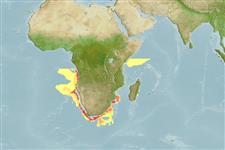Elasmobranchii (Haie und Rochen) (sharks and rays) >
Squaliformes (Sleeper and dogfish sharks) >
Etmopteridae (Lantern sharks)
Etymology: Etmopterus: Greek, ethmos, -ou = sieve or ethmoides bone + Greek, pteron = wing, fin (Ref. 45335).
Eponymy: Dr Leonard Joseph Victor Compagno (d: 1943) is an American ichthyologist, internationally recognized as authority on shark taxonomy. [...] (Ref. 128868), visit book page.
More on authors: Fricke & Koch.
Environment: milieu / climate zone / depth range / distribution range
Ökologie
seewasser; tiefenbereich 383 - 1300 m (Ref. 106604). Deep-water
Southeast Atlantic: off southwestern Cape Province and northern Natal in South Africa (Ref. 6577, 11228). Etmopterus compagnoi was formerly confused with Etmopterus gracilispinis Krefft 1968 which also occurs off the eastern Cape and northern Natal.
Length at first maturity / Size / Gewicht / Alter
Maturity: Lm ?, range 55 - ? cm
Max length : 78.0 cm TL Männchen/unbestimmt; (Ref. 11228)
Kurzbeschreibung
Bestimmungsschlüssel | Morphologie | Morphometrie
Dark brown in color with no conspicuous flank margins (Ref. 6577).
Found in deep water. Males mature at 55 cm. Ovoviviparous (Ref. 205).
Life cycle and mating behavior
Geschlechtsreife | Fortpflanzung | Ablaichen | Eier | Fecundity | Larven
Distinct pairing with embrace (Ref. 205).
Heemstra, P.C., 1995. Additions and corrections for the 1995 impression. p. v-xv. In M.M. Smith and P.C. Heemstra (eds.) Revised Edition of Smiths' Sea Fishes. Springer-Verlag, Berlin. (Ref. 11228)
IUCN Rote Liste Status (Ref. 130435: Version 2024-2)
Bedrohung für Menschen
Harmless
Nutzung durch Menschen
Fischereien: nicht kommerziell
Tools
Zusatzinformationen
Download XML
Internet Quellen
Estimates based on models
Preferred temperature (Ref.
123201): 5.2 - 10.9, mean 8.8 °C (based on 22 cells).
Phylogenetic diversity index (Ref.
82804): PD
50 = 0.5000 [Uniqueness, from 0.5 = low to 2.0 = high].
Bayesian length-weight: a=0.00380 (0.00194 - 0.00745), b=3.09 (2.92 - 3.26), in cm total length, based on LWR estimates for this Genus-body shape (Ref.
93245).
Trophic level (Ref.
69278): 4.3 ±0.3 se; based on diet studies.
Widerstandsfähigkeit (Ref.
120179): niedrig, Verdopplung der Population dauert 4,5 - 14 Jahre. (Fec assumed to be <100).
Fishing Vulnerability (Ref.
59153): Moderate to high vulnerability (51 of 100).
